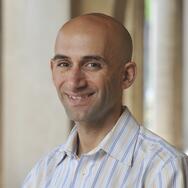California Emergency Department Visits During Wildfire Smoke Events
California Emergency Department Visits During Wildfire Smoke Events
Eran Bendavid and his Stanford colleagues examine how often Californians visit emergency departments (ED) and found that, surprisingly, people tend to avoid the hospital on the smokiest days.

As the intensity of wildfires increase across North America — so do their impacts on our health. Exposure to high levels of smoke can trigger asthma and heart attacks in the short-term, then elevate COPD or take years off one’s life expectancy with long-term exposure.
While the United States had seen decades of falling levels of fine particulate matter pollution (PM2.5) in the air, the increasing intensity of wildfires and smoke of the last few years has slowed or even reversed the progress toward cleaner air in 35 states — erasing a quarter of the gains made since 2000.
Among the many studies underway by Stanford researchers about the health impacts of wildfire smoke is a new investigation that looks at how wildfires can alter behaviors in ways that intertwine with their health. They looked at how often Californians visit emergency departments (ED) and found that, surprisingly, people tend to avoid the hospital on the smokiest days.
The researchers used geolocated data covering all emergency department visits to nonfederal hospitals in California from 2006 to 2017. They then combined that data with estimates of daily wildfire smoke containing tiny particles known as PM2.5, which can burrow into the lungs and even make their way into the bloodstream.
“Particulate matter air pollution is one of the leading global risk factors, and even modest declines in air quality have measurable harms, especially for the young and the old,” said Eran Bendavid, an associate professor of health policy and a senior fellow at the Woods Institute for the Environment. He is co-author of a new paper in the Proceedings of the National Academy of Sciences (PNAS) with lead author Sam Heft-Neal and senior author Marshall Burke.
They found that total visits to emergency rooms increase with worsening wildfire smoke, up to a point. Seemingly counterintuitive, the total visits actually decline when wildfire smoke is at its worst. Relative to a day with no smoke, total visits increase by 1 to 1.5% in the week following low or moderate smoke days, but decline by 6 to 9% following extreme smoke days.
Declines at extreme levels are driven by diagnoses not thought to be acutely impacted by pollution, such as accidental injuries and several non-urgent symptoms.
“In contrast, health outcomes with the strongest physiological link to short-term air pollution increase dramatically in the week following an extreme smoke day. We estimated that ED visits for asthma, COPD, and cough all increase by 30 to 110%,” they wrote. They estimated that overall, smoke was responsible for an average of 3,010 additional emergency room visits per year from 2006 to 2017.
The authors find that evidence for behaviors leading to ED avoidance is more compelling than simply fewer injuries, which would also lead to fewer emergency department visits. Taking data from internet searches, vehicle traffic sensors and park visits, the authors found widespread behavioral changes on high-smoke days, consistent with their findings on health-care utilization.
“Wildfires in the West are a problem and a conundrum: they lead to more respiratory illnesses, and also change behaviors to reduce use of Emergency Departments. The implications of this complex story are not fully clear,” Bendavid said.
The same research team has also examined the high risk of infant mortality due to dust pollution in sub-Saharan Africa and how air pollution is amplifying the impacts of climate change.
The other authors of the paper are Carlos F. Gould, Matthew V. Kiang and Mark Duggan of Stanford; and Marissa L. Childs and Kari C. Nadeau of Harvard University.




